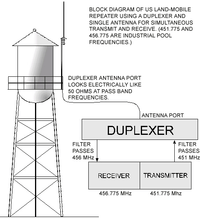Duplexer
A duplexer is an electronic device that allows bi-directional (duplex) communication over a single path. In radar and radio communications systems, it isolates the receiver from the transmitter while permitting them to share a common antenna. Most radio repeater systems include a duplexer. Duplexers can be based on frequency (often a waveguide filter), polarization (such as an orthomode transducer), or timing (as is typical in radar).[1]
Types
Transmit-receive switch

In radar, a transmit/receive (TR) switch alternately connects the transmitter and receiver to a shared antenna. In the simplest arrangement, the switch consists of a gas-discharge tube across the input terminals of the receiver. When the transmitter is active, the resulting high voltage causes the tube to conduct, shorting together the receiver terminals to protect it, while its complementary, the anti-transmit/receive (ATR) switch, is a similar discharge tube which decouples the transmitter from the antenna while not operating, to prevent it from wasting received energy.
Circulator
Orthomode transducer
Frequency domain

In radio communications (as opposed to radar), the transmitted and received signals can occupy different frequency bands, and so may be separated by frequency-selective filters. These are effectively a higher performance version of a diplexer, typically with a narrow split between the two frequencies in question (typically around 2%-5% for a commercial two-way radio system).
With a duplexer the high and low frequency signals are traveling in opposite directions at the shared port of the duplexer.
Modern duplexers often use nearby frequency bands, so the frequency separation between the two ports is also much less. For example, the transition between the uplink and downlink bands in the GSM frequency bands may be about 1 percent (915 MHz to 925 MHz). Significant attenuation (isolation) is needed to prevent the transmitter's output from overloading the receiver's input, so such duplexers will employ multi-pole filters. Duplexers are commonly made for use on the 30-50 MHz ("low band"), 136-174 MHz ("high band"), 380-520 MHz ("UHF"), plus the 790–862 MHz ("800"), 896-960 MHz ("900") and 1215-1300 MHz ("1200") bands.
There are two predominant types of duplexer in use - "notch duplexers", which exhibit sharp notches at the "unwanted" frequencies and only pass through a narrow band of wanted frequencies and "bandpass duplexers", which have wide pass frequency ranges and high out of band attenuation.
On shared antenna sites, the bandpass duplexer variety is greatly preferred because this virtually eliminates interference between transmitters and receivers by removing out of band transmit emissions and considerably improving the selectivity of receivers. Most professionally engineered sites ban the use of notch duplexers and insist on bandpass duplexers for this reason.

Isolation typical >75 dB
Insertion Loss typical < 1.0 dB
Note 1: A duplexer must be designed for operation in the frequency band used by the receiver and transmitter, and must be capable of handling the output power of the transmitter.
Note 2: A duplexer must provide adequate rejection of transmitter noise occurring at the receive frequency, and must be designed to operate at, or less than, the frequency separation between the transmitter and receiver.
Note 3: A duplexer must provide sufficient isolation to prevent receiver desensitization.
Source: from Federal Standard 1037C
References
- ↑ Rinehart, Ronald E. (1991). Radar for Meteorologists. University of North Dakota. radar engineers have added the automatic switch (also called a duplexer) in the ... As soon as the transmitter stops sending a signal, the duplexer switches so that the receiver is now connected to the antenna.